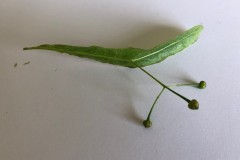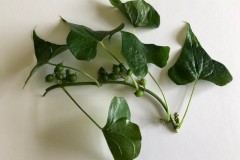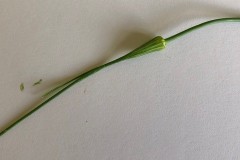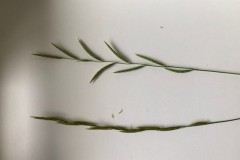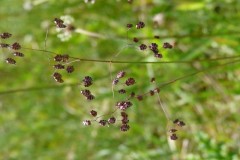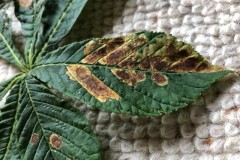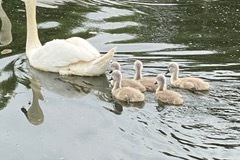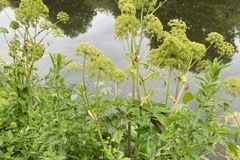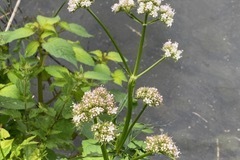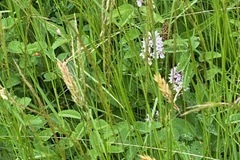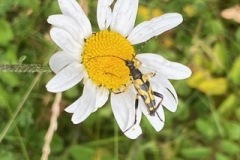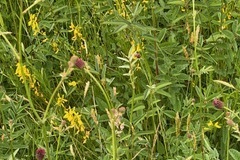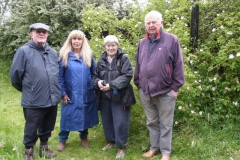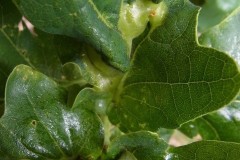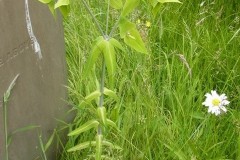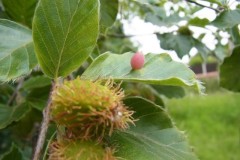Leader : Carl & Tony (of the Friends).
Members present: NB, CH from the Nats & from the friends Alan, Fenella, Neil and at least three others (apologies for not recording your names).
The Nats had been invited by the Friends of Denaby Crags to accompany them on a walk around the crags and point out any interesting summer-time plants and animals. For Nats members who couldn’t attend … well, you missed a treat. The Friends, living up to their name, are a most agreeable and convivial (see later) bunch who in casual conversation revealed a breadth of interests and expertise and an eagerness to learn more about their beloved Denaby/Conisbrough area.
In earlier visits we had looked at elements of ancient woodland (Denaby Thick) and the development of Community Woodland, planted during the hard times of the 1980s. Today we looked at the species-rich grassland of the Limestone Crags, directing our attention particularly to the Lady’s Quarry area (SK5099). Walking up the steep but newly engineered and tarmacked pathways we were delighted to see the newly erected totem-like oak marker posts indicating the former coal and limestone industries. Nora drew or attention to the abundantly flowering and fruiting Lime trees, noting that these were similar to the rare native Small-leaved Lime (Tilia cordata) and Large-leaved Lime (T. platyphylos). Cultivated hybrids between these two parents are the more frequently planted Common Lime (Tilia x europaea).
Emerging from the woodland edge shrubby habitats of Blackthorn (Prunus spinose), Dogwood (Cornus sanguinea), Guelder Rose (Viburnum opulus), Hazel (Corylus avellana) and Hawthorn (Crataegus monogyna), vines of Black Bryony (Tamus communis) scrambled up through these shrubs displaying their dark green heart-shapes leaves and orange berries. Another vigorous climber was the Tufted Vetch (Vicia cracca) with its racemes of purplish-blue florets (up to 40 florets per stem). Some plants were already developing their inch-long brown seed pods. On the edge of the grassland were stands of yellow-green Wood Sage (Teucreum scorodonia) and colonies of slim pale-yellow flowering spikes (up to 2ft tall) of Agrimony (Agrimonia eupatoria). Along the main paths the grassland contained an abundance of flowering White Clover (Trifolium repens), Red Clover (T. pratense) and the larger, looser purple-red flowering heads of the Zigzag Clover (T. medium).
Characteristic of the shorter or path-side grassland were clumps of the yellow flowering Bird’s-foot Trefoil (Lotus corniculatus), food plant for the Common Blue Butterfly. Another member of the pea family and one of the highlights of the Lady’s Quarry area were patches of Restharrow (Ononis repens) with its attractive pink winged and keeled flowers. This rather local limestone plant with woody stems and downy leaves is the food plant of the Restharrow Plume Moth. This diaphanous low-flying insect has a very restricted distribution and although not recorded for the Crags, the abundance of its food plant suggests it may be here, just waiting to be discovered.
It was interesting to find patches of two native members of the Onion family, sadly neither were sufficiently well developed for a confident identification but were possibly Field Garlic (Allium oleraceum) and Wild Leek (Alium ampeloprasum). Anyhow, after a tentative nibble, Tony confirmed that they both tasted of chives.
Moving out onto the waist-high grassland were tangles of the Meadow Vetchling (Lathyrus pratensis) with their bunches of yellow pea flowers. Growing up in frothy mounds of tiny flowers are the scrambling patches of white Hedge Bedstraw (Galium mollugo) and golden yellow Lady’s Bedstraw (G. verum), the latter, pleasantly aromatic. Further swatches of colour were provided by beds of red-purple Knapweed (Centaurea nigra), the more flamboyant Greater Knapweed (C. scabiosa) and the 3ft tall blue-violet Field Scabious (Knautia arvensis).
As yet un-mown, un-grazed or un-burned, the limestone-loving grasses are now magnificently at waist-height, the tallest being Tor-grass (Brachypodium pinnatum) and Upright Brome (Bromus erectus). Other tall but more ubiquitous wayside grasses are False Oat-grass (Arrhenatherum elatius) and Cock’s-foot Grass (Dactylis glomerata), all food-plants of a range of butterflies, moths and grasshoppers. A more delicate grass of the Lady’s Quarry is the very attractive Quaking Grass (Briza media), though patches of grass particularly noticed by the Friends were path-side beds of a Bent Grass (Agrostis sp.) the microscopically fine seed heads seeming to hover like a mist over their dark green foliage. During our visit and in this elevated position, the boisterous wind was thrashing the sward into a sea of wave-like pulses … so no butterflies today!
Areas regularly burned in summer grass-fires, or the sites of fly-tipping bonfires, have been colonised by shoulder-height luminous magenta spikes of Rosebay Willowherb or Fire-weed (Chamerion angustifolium) … a feature of war-time bomb-sites of nearby Sheffield and Rotherham. These very striking plants are a preferred food of the impressive Elephant Hawkmoth.
On our way from the Lady’s Quarry we passed several saplings of Horse-chestnut (Aesculus hippocastanum), the products of previous years’ conkers. Their huge palmate leaves were striped with pale patches caused by Leaf Miners, tiny caterpillars feeding on the pithy layers of plant tissue beneath the leaf epidermis. Later this summer these caterpillars will pupate and emerge as stunningly attractive ginger and black chevron-striped Horse-chestnut Micro Moths (Cameraria ohridella). This remarkable, if minute contribution to our biodiversity, was discovered new to science in Macedonia as recently as 1986. It was first noticed in Britain in 2002 and by 2008 the Nats had found it was already widespread on the ‘conker’ trees of the Doncaster district.
To round off a most interesting day we made our way to the picnic/socialising area of the adjacent allotment gardens where in the sunshine the friends had prepared an array of sandwiches, soft drinks and wine. Even this socialising area was well designed. The pea-gravel area had been planted with a chequer-board of colourful violas and its boundary sported an informal array of flowers including cornfield annuals. Convivial chatter was punctuated by examination of collected specimens. In fact, as they say in these parts, we made as much rattle as a can-a-mabs (=a tin of marbles).
Photographic opportunity: With the grassland flowers of the Crags currently being at their best, any photographers amongst the Friends should quickly capture images of the main plants and their habitats for the Crags website. An opportune occasion would be during the scheduled walk with Jim Horsfall and the Sorby Natural History Society on 6 July.
CAH.
Members present: MP, JP, NB, CH and guest DG (Chairman of the Yorkshire Naturalists’ Union Flowering Plants section).
Apart from a short but intense downpour at lunchtime, when the group adjourned to the Hall café for shelter and refreshments (generously provided by Tom), we had warm sunny weather all day 10.30 am to 4.30 pm.
Although the gardens were intensely managed for horticultural perfection and historical authenticity, the richness and abundance of the site’s natural biodiversity was remarkable.
It was impressive to be surrounded by the immaculate management of topiaried trees and shrubs, historically accurate bedding plots and close-mown/striped lawns. However, it was fascinating and heartening to note to that at every opportunity, between and to the rear of these expressions of excellence, areas had been left for the native flora to express itself (grow, flower and seed).
No weeds these … here we encountered whole communities of limestone grassland and woodland- edge floras, including regional and national rarities, which in the countryside at large have become extremely scarce and under threat.
It was also intriguing and heartening to see how the gardening staff were encouraging visitor participation in (for instance) the appreciation of the species-rich lawns with the sign that read:
“What’s on Today”
“Can you spot any of the Bee Orchids hidden in the grass??”
Notable plant communities and natural history features included the following:
- The shaded woodland of the Pet’s cemetery where there is a progression from Smooth Meadow grass Poa pratensis which is replaced by the shade-requiring Poa nemoralis which in turn gives way to the woodland classics Wood Melic Melica uniflorq and Wood Sedge Carex sylvatica.
- In the ‘Hay meadow’ area dominated by Upright Brome Bromus erectus, the Rest Harrow Ononis repens is one of the Yorkshire sites for the specialist Rest Harrow Plume Moth (Ref: Notes on the Rest-harrow Plume Moth (Marasmarcha lunaedactyla): A vulnerable element in Yorkshire’s biodiversity. Bulletin of the Yorkshire Naturalists’ Union. (1999) 32: 29-32.
- By the path dropping down to the rose gardens, the steep cutting, shaded by beech canopy and clad with Vinca minor and Poa nemoralis is a colony of the delicate Maiden Pink Dianthus deltoids. Very rare in Yorkshire but probably a native here, though only known in the literature at Brodsworth since 2010 (Ref: Maiden Pink Dianthus deltoides at Brodsworth Park. Yorkshire Naturalists’ Union Website 2010 YNU.org.uk).
- The Foxgloves, on a curving path running down to the rose gardens, were being worked by a number of nectaring insects including a range of bumble bees. It was interesting to watch them working the florets in the spiralling fibonacci sequence of the plant’s structure. To encourage Bumble bees, it would be useful to install underground Bumble bee nesting boxes (upturned terracotta plant pots) around the park (info from: https://www.dartmoor.gov.uk/enjoy-dartmoor/funzone/make-a-bumblebee-nest-box).
- Unmown grassland to the rear or between heavily managed features frequently supported ranges of orchids. One swarm included over 80 Spotted Orchids Dactylorhiza fuchsii and nearby were more, together with Bee Orchid Ophrys apifera, Twayblade Neottia ovata and Southern Marsh Orchids Dactylorhiza praetermissa.
- Coming from the church to the main drive, to the rear of a cleared bed in front of topieried shrubs was a very fine fruiting clump of the Prickly Sedge Carex muricata. This is by far the most impressive example of this plant in the Doncaster region and represents one of the very few South Yorkshire sites for this national rarity.
These and no doubt many more features of natural history interest are a tribute to the skill, knowledge and positive attitude of the gardening staff/management. We hope these comments may be of assistance to the continuation of their impressive work.
The following table is a list of species encountered during our visit:
| Scientific name | Vernacular name |
|---|---|
| Achillea millefolium | Yarrow |
| Aegopodium podagraria | Ground Elder |
| Alchemilla sp. | Lady’s Mantle |
| Angelica sylvestris | Wild Angelica |
| Aquilegia vulgaris | Columbine |
| Arrhenatherum elatius | False Oat-grass |
| Bellis perennis | Daisy |
| Brachipodium sylvaticum | Slender False-brome |
| Briza media | Quaking Grass |
| Bromus erectus | Upright Brome |
| Carex muricata | Prickly Sedge |
| Carex sylvatica | Wood Sedge |
| Centaurea nigra | Knapweed |
| Cerastium fontanum | Mouse-eared Chickweed |
| Cicaea lutetiana | Enchanters Nightshade |
| Cirsium arvense | Creeping Thistle |
| Cirsium vulgare | Spear thistle |
| Conopodium majus | Pignut |
| Cynosurus cristatus | Crested Dogtail |
| Dactylis glomerata | Cock’s-foot Grass |
| Dactylorhiza praetermissa | Southern Marsh Orchid |
| Fagus sylvatica | Beech |
| Fagus sylvatica pupurea | Copper Beech |
| Fragaria vesca | Wild Strawberry |
| Galium aparine | Cleavers |
| Galium verum | Lady’s Bedstraw |
| Geranium dissectum | Cut-leaved Cranesbill |
| Geranium molle | Dove’s-foot Cranesbill |
| Geranium robertianum | Herb Robert |
| Geum urbanum | Wood Avens |
| Holcus lanatus | Yorkshire Fog |
| Hypericum androsaemum | Tutsan |
| Hypericum hirsutum | Hairy St. John’s-wort |
| Lamium purpureum | Red Dead-nettle |
| Lapsana communis | Nipple-wort |
| Lathyrus pratensis | Meadow Pea |
| Leucanthemum vulgare | Ox-eye Daisy |
| Lolium perenne | Rye Grass |
| Lotus corniculatus | Bird’s-foot Trefoil |
| Melica uniflora | Wood Melic |
| Mercurialis perennis | Dog’s Mercury |
| Neottia ovata | Twayblade |
| Ophrys apifera | Bee-orchid |
| Plantago laneolata | Ribwort Plantain |
| Plantago media | Hoary Plantain |
| Poa pratensis | Smooth Meadow-grass |
| Primula veris | Cowslip |
| Prunella vulgaris | Selfheal |
| Quercus ilex | Holme Oak |
| Quercus robur | English Oak |
| Ranunculus acris | Meadow Buttercup |
| Ranunculus repens | Creeping Buttercup |
| Rhinanthus minor | Yellow Rattle |
| Rumex sanguineus | Wood Dock |
| Sanguisorba minor | Salad Burnet |
| Sanicula europaea | Wood Sanicle |
| Silene dioica | Red Campion |
| Stachys sylvatica | Hedge Woundwort |
| Tamus communis | Black Bryony |
| Taxus baccatus | Yew |
| Thymus sp. | Thyme sp. |
| Tilia sp | Lime |
| Trifolium pratense | Red Clover |
| Trifolium reptens | White Clover |
| Trisetum flavescens | Yellow Oat |
| Ulmus glabra | Wych Elm |
| Veronica serpyllifolia | Thyme Speedwell |
| Vinca minor | Lesser Periwinkle |
| Viola riviniana | Common Dog Violet |
| Scientific name | Vernacular name |
|---|---|
| BIRDS | |
| Columba palumbus | Wood Pigeon |
| Corvus monedula | Jackdaw |
| Cyanistes caeruleus | Blue Tit |
| Dendrocopos major | Great-spotted Woodpecker |
| Erithacus rubecula | Robin |
| Fringilla coelebs | Chaffinch |
| Phylloscopus collybita | Chiffchaff |
| Pica pica | Magpie |
| Sitta europaea | Nuthatch |
| Turdus merula | Blackbird |
| COLEOPTERA | |
| Clytus arietis | Wasp Beetle |
| HYMENOPTERA | |
| Apis mellifera | Honey Bee |
| Bombus hypnorum | Tree Bumblebee |
| Bombus lapidarius | Red-tailed Bumblebee |
| Bombus lucorum | White-tailed Bumblebee |
| Bombus pratorum | Early Bumblebee |
| DIPTERA | |
| Episyrphus balteatus | Marmalade Hoverfly |
| Eristalis tenax | Drone Fly |
| Syrphus ribesii | Hoverfly |
| LEPIDOPTERA | |
| Aphantopus hyperantus | Ringlet (Butterfly) |
| Maniola jurtina | Meadow Brown (Butterfly) |
| Mythimna ferrago | The Clay (Moth) |
| Pammene aurita | Sycamore piercer (A micro moth) |
| FUNGI | |
| Laetiporus sulphureus | Chicken in the woods |
| Polyporus squamosus | Dryads Saddle |
Members present: JB, TH & CH.
Blue-tailed damselfly
Black tailed skimmer
Red eyed damselfy
Banded demoiselle
A pair of mute swans with five cygnets
Marsh Woundwort
Smooth Sow thistle
Black medic – John helpfully pointed out that black medic has a point at the end of the leaf
unlike lesser trefoil
Floating pennywort
Flowering rush – interesting twisty stem
Angelica – cultivated form – Louise – For info – Grid Ref: SE648182
Louise – For info – Grid Ref: SE648181
Marsh bedstraw
Oval sedge
Marsh Thistle
Carex remota
Persicaria
Lesser swinecress
Pepper saxifrage
Meadowsweet
Yellow shell moth
Small skipper
Common blue
Meadow brown
Speckled wood
We should have taken a leaf out of Rudyard Kipling’s ‘Just So Stories’ and introduced it as Tim’s expedition “To the banks of the great grey-green greasy Shirley Pool, all set about with fever trees”.
It took place on a seemingly hot day when the impenetrable fens were impenetrably fenny and the impenetrable wet woodlands (despite the drought) were impenetrably soggy and the mosquitos and other biting dipterans were inclining to be a bit too friendly.
It was like stepping back into the world of the 18th/19th century local Botanists – Thomas Tofield (1730-1779); Margaret Stovin (1756-1846); William Pilkington (1758-1848); Jonathan Salt (1759-1810); George Nicholson (fl.1830s); Rev. Gerard Edwards Smith (fl. 1844 to 1846); Oswald Allen Moore (d.1862); Samuel Appleby (1806-1870); Peter Inchbald (1816-1896); Mary Yarborough (fl. 1830s); J. E. Kenyon (fl.1864); T. W. Gissing (1829-1870); Thomas Birks (fl. 1870s-80s); Franklin Parsons (fl. 1870s); and Dr H. H. Corbett (1856-1921).
Tim wasn’t just showing us odd specimens of key wetland plants of pre enclosure landscapes, he was taking us to where they dominated and were in charge. Ancient contorted coppiced Alders and Oaks were like the Ents from the forests of Tolkien’s Middle-earth and in the closed canopy settings of the Willow carrs, the blizzards of wind-borne flocculent willow seeds had settled on every twig and surface, giving the impression of a winter wonderland … though sweltering in the mid 20s C!
There were banks and beds of Marsh Fern Thelypteris palustris, jungles of Great Water Dock Rumex hydrolapathum and amongst Phragmites reed beds were stands of the Great Fen Sedge Cladium mariscus. In open fenny grassland were beds of Meadow Rue Thalictrum flavum with the delightful Ragged Robin Silene flos-cuculi, and generally there were enough Sedges and Rushes to occupy you for an entire Open University Course.
Thank you Tim (and the Carstairs Trust) for a most remarkable day of exploration but gosh (!) you made us suffer for our art.
CAH
Leader: Jim Burnett.
Also present: JN, TH, CH and two guests from Misson.
As JN remarked, this was the watery landscape by the river Idle we identified at a distance, looking down from the elevated vantage point of Barrow Hills during our spring visit back on 27 March.
On a dazzlingly bright and enervatingly hot day, the group walked along Slaynes Lane from the Austerfield end (SK667937) through to the outskirts of Misson village (SK688946), having lunch at the slightly elevated bird-watching outlook off the eastern side of Slaynes Lane (SK686943).
The meandering river Idle flowed from south-west to north-east beyond the flooded/subsided former arable land. Running along the south side of Slaynes Lane (from SK 680939 to 687945) is a deep wide flooded drain, its banks supporting dense beds of riparian vegetation dominated by Great Reed Phragmites australis, Reedmace Typha latifolia, Reed Sweet-grass Glyceria maxima, Reed Canary-grass Phalaris arundinaces, with Water Figwort Scrophularia auriculata , Yellow Iris Iris pseudacorus and Hemlock Conium maculatum. This zone, currently supporting Reed Warblers, Sedge Warblers and Reed Buntings, would be ideal to visit in autumn/winter to search for Harvest Mouse nests.
From the several concrete bridges across this drain it was possible to watch a busy traffic of Odonata consisting of Banded Demoiselle (Calopterix splendens), Common Blue Damselfly (Enallagma cyathigerum) and Black-tailed Skimmers (Ortherum cancellatum). Aquatic plants in the drain included the algae Enteromorpha intestinalis [actually a sea-weed!], Branched Bur-reed Sparganium erectum, Water Plantain Alisma plantago-aquatica, Waterweed Elodea sp., Starwort Callitriche sp., Duckweed Lemna sp. and Water Milfoil Myrophyllum sp. Seen from one of the bridges, outliers of a shoal of fish fry (possibly Roach) were being stalked by two very young (4-6 inches long) Pike Esox lucius.
The once arable fields along the north side of Slaynes Lane have been quarried for their sand and gravel deposits, a legacy of the post glacial Lake Humber. These are now open water bodies with numerous water birds and, due to the prolonged drought, extensive shorelines and mud banks providing feeding/roosting areas for wading birds.
| Scientific Name | Vernacular Name |
|---|---|
| Alisma plantago-aquatica | Water Plantain |
| Anthriscus sylvestris | Cow Parsley |
| Arctiom minus | Lesser Burdock |
| Arrhenatherum elatius | False Oat-grass |
| Artemisia vulgaris | Mugwort |
| Ballota nigra | Black Horehound |
| Callitriche sp. | Water Starwort |
| Capsella bursa-pastoris | Shepherd’s Purse |
| Cirsium arvense | Creeping Thistle |
| Cirsium vulgare | Spear Thistle |
| Conium maculatum | Hemlock |
| Convolvulus arvensis | Field Bindweed |
| Dactylis glomerata | Cock’s foot-grass |
| Enteromorpha intestinalis | Gut-weed (Algae) |
| Epilobium hirsutum | Great Willowherb |
| Euphorbia lathrys | Caper Spurge |
| Galium aparine | Cleavers |
| Geranium dissectum | Cut-leaved Geranium |
| Geranium molle | Dove’s-foot Cranesbill |
| Glyceria maxima | Reed Sweet-grass |
| Heracleum sphondylium | Hogweed |
| Humulus lupulus | Hop (In hedgerow as lane entered Misson) |
| Iris pseudacorus | Yellow Iris |
| Lactuca serriola | Prickley Lettuce |
| Lamium album | White Dead-nettle |
| Lamium purpureum | Red Dead-nettle |
| Lemna sp. | Duck-weed |
| Lolium perenne | Rye-grass |
| Lonicera periclymenum | Honeysuckle |
| Malva sylvestris | Mallow |
| Matricaria discoidea | Pineapple weed |
| Myrophyllum sp. | Water Milfoil |
| Papaver rhoeas | Red Poppy |
| Persicaria amphibian | Amphibious Bistort |
| Phalaris arundinaces | Reed Canary-grass |
| Phragmites australis | Great Reed |
| Picris echioides | Bristly Ox-tongue |
| Plantago lanceolatum | Lanceolate Plantain |
| Poa annua | Annual Meadow-grass |
| Poa pratensis | Smooth Meadow-grass |
| Ranunculus repens | Creeping Buttercup |
| Reseda luteola | Weld |
| Rosa canina | Dog Rose |
| Rubus fruticosus | Bramble |
| Rumex crispus | Curly Dock |
| Rumex obtusifolius | Broad Dock |
| Salix cinerea | Grey Willow |
| Salix fragilis | Crack Willow |
| Scrophularia auriculata | Water Figwort |
| Silene dioica | Red campion |
| Silene latifolia | White campion |
| Sisymbrium officinale | Hedge Mustard |
| Sonchus asper | Prickly Sow-thistle |
| Sonchus oleraceus | Smooth Sow-thistle |
| Sparganium erectum | Branched Bur-reed |
| Thalictrum flavum | Common Meadow-rue |
| Trifolium repens | White Clover |
| Tripleurospermum inodorum | Scentless Mayweed |
| Typha latifolia | Reedmace |
| Urtica urens | Stinging Nettle |
| Scientific Name | Vernacular Name |
|---|---|
| Blackheaded Gull 120+ | |
| Canada Goose | |
| Carrion Crow | |
| Common Tern 2+ | |
| Coot 20 + 43 | |
| Cormorant | |
| Gadwall | |
| Great Crested Grebe 2+ pairs | |
| Grey Heron | |
| Grey-lag Goose 6 + goslings | |
| House Sparrow | |
| Lapwing 2 + | |
| Little Egret 5 | |
| Mallard 4 + 6 | |
| Mute Swan 39 + 2 | |
| Oystercatcher 4 + 6 | |
| Reed Bunting | |
| Reed Warbler | |
| Sand Martin | |
| Sedge Warbler | |
| Song Thrush | |
| Tufted Duck 6 + | |
| Whitethroat | |
| Willow Warbler | |
| Wood Pigeon | |
| Wren |
| Scientific Name | Vernacular Name |
|---|---|
| Calopterix splendens | Banded Demoiselle |
| Enallagma cyathigerum | Common Blue Damselfly |
| Ortherum cancellatum | Black-tailed Skimmer |
| Scientific Name | Vernacular Name |
|---|---|
| Gerris lacustris | A Pondskater |
Leader : Tricia Haigh
It’s hard to imagine that after all these hot sunny days a fortnight ago it was a cool and cloudy afternoon with a chilly wind when we met in Finningley churchyard. I was joined by Nora and Gerri from the Nats and 2 other members of our church family. Having checked out the field in advance I decided there was little of interest compared with last year to make a visit worthwhile.
We spent just over 2 hours walking around our churchyard and the new burial ground looking principally at the botany but noting any wildlife seen, including a Swollen-thighed Beetle that I spotted when I first arrived on an Ox-eye Daisy flower but was unable to photograph before it moved off. Although I hadn’t seen these beautiful insects before last year I’ve seen a number recently. A few small beetles were spotted and gradually more bees were observed, including several that I found feeding on the flowers of Cotoneaster species growing near the Hollies just after everyone had left, including a Tree Bumblebee (photographed).
Mildew was noted on some plants, in particular White Deadnettle growing in the border near the rear entrance. Two new plant species first noted in May were seen. The first, a garden escape, was Pink Sorrel, Oxalis articulata. Another first spotted in May was a Caper Spurge, Euphorbia lathyris, which on this occasion was found in flower and photographed. Another new record for the churchyard was Mouse-ear Hawkweed, Pilosella officinarum. This has been recorded for a number of years in the new burial ground but despite the number that were flowering alongside Common Cat’s-ear in the western end of the churchyard it was the first time I had seen it growing there.
In the churchyard a few Mikiola fagi galls were found on Beech leaves, single galls on individual leaves. This newly discovered gall caused interest last year when it was found as it was not a common sighting. In the new burial ground oak leaves were scrutinised and Nora discovered a good example of the gall wasp Andricus curvator on Quercus robur, a first record of this gall for Finningley (photographed). Another gall was found and photographed, which as yet has not been identified.
| Vernacular Name | Botanical Name | Comments |
|---|---|---|
| Cat’s-ear | Hypochaeris radicata | |
| Field Woodrush / Good Friday Grass | Luzula campestris | |
| Yorkshire Fog | Holcus lanatus | |
| Cock’s-foot | Dactylis glomerata | |
| Sweet Vernal Grass | Anthoxanthum odoratum | |
| Brome sp | ||
| Ox-eye Daisy | Leaucanthemum vulgare | |
| Meadow Buttercup | Ranunculus acris | |
| Ribwort Plantain | Plantago lanceolata | |
| Lady’s Bedstraw | Galium verum | In bud |
| Lesser Stitchwort | Stellaria graminea | |
| Herb Robert | Geranium robertianum | |
| Greater Periwinkle | Vinca major | |
| Pink Sorrel | Oxalis articulata | Garden escape first recorded May 2023 |
| Cleavers / Goosegrass | Galium aparine | |
| Sorrel, Common | Rumex acetosa | |
| Nipplewort | Lapsana communis | |
| White Bryony | Bryonia dioica | |
| Germander Speedwell | Veronica chamaedrys | |
| Common Ragwort | Senecio jacobaea | Not yet in flower |
| Goat’s-beard | Tragopogon pratensis | |
| Smooth Sowthistle | Sonchus oleraceous | |
| Columbine | Aquilegia vulgaris | |
| Wall-rue | Asplenium ruta-muraria | |
| Male Fern | Dryopteris filix-mas | |
| Red Campion | Silene dioica | |
| Stinging Nettle | Urtica dioica | |
| Common Vetch | Vicia sativa | |
| Asparagus | Asparagus officinalis | |
| Hogweed | Heracleum sphondylium | |
| Common Mouse-ear | Cerastium fontanum | |
| Smooth Hawk’s-beard | Crepis capillaries | |
| Caper Spurge | Euphorbia lathyris | First recorded May 2023 |
| Hairy Tare | Vicia hirsute | |
| Hop Trefoil | Trifolium campestre | |
| White Deadnettle | Lamium album | |
| Spear Thistle | Cirsium vulgare | In bud |
| Dove’s-foot Crane’s-bill | Geranium molle | |
| Broad-leaved Dock | Rumex obtusifolius | |
| Garlic Mustard | Alliaria petiolata | |
| Creeping Thistle | Cirsium arvense | Not yet in flower |
| Opium Poppy | Papaver somniferum | In bud |
| Stinking Iris | Iris foetidissima | |
| Ground Elder | Aegopodium podagraria | |
| Lesser Stitchwort | Stellaria graminea | |
| Common Bird’s-foot Trefoil | Lotus corniculatus | |
| Salad Burnet | Sanguisorba minor | |
| Mouse-ear Hawkweed | Pilosella officinarum | 1st record in churchyard (west end). |
| Daisy | Bellis perennis | |
| Lady’s Smock | Cardamine pratensis | |
| Hedgerow Crane’s-bill | Geranium pyrenaicum | |
| Shining Crane’s-bill | Geranium lucidum | |
| Hedge Woundwort | Stachys sylvatica | |
| Lesser Periwinkle | Vinca minor | |
| Wild Arum / Cuckoo Pint | Arum maculatum | Going over |
| Stinking Hellebore | Helleborus foetidus | |
| Herb Bennet / Wood Avens | Geum urbanum | |
| Bittersweet | Solanum dulcamara | |
| Greater Celandine | Chelidonium majus | |
| Honesty | Lunaria annua | |
| Green Alkanet | Pentaglottis sempervirens | |
| Greater Stitchwort | Stellaria holostea | Going over |
| Thyme-leaved Speedwell | Veronica serpyllifolia | |
| Wall Barley | Hordeum murinum | |
| Ground Ivy | Glechoma hederacea | |
| Wavy Hairgrass | Deschampsia flexuosa | New graveyard |
| White Stonecrop | Sedum album | New graveyard |
| Vernacular Name | Botanical Name | Comments |
|---|---|---|
| Field Maple | Acer campestre | Sapling found 2 years ago, so far it hasn’t been strimmed or mown this year |
| Dog Rose | Rosa canina | |
| Cotoneaster | Cotoneaster franchetii | |
| Forsythia | Forsythia sp | |
| Silver Birch | Betula pendula | |
| Field Rose | Rosa arvensis | In bud |
| Flowering Currant | Ribes sanguineum | Berries forming |
| Wild Cherry | Prunus avium | |
| Cherry Laurel | Prunus laurocerasus | |
| Oregon Grape | Mahonia aquifolium | |
| Bramble | Rubus fruticosus | |
| Buddleia sp | Buddleia davidii | |
| Elm sp | Ulmus sp | |
| Elder | Sambucus nigra | |
| Darwin’s Barberry | Berberis darwinii | |
| Rose “Rambling Rector” | Rosa “Rambling Rector” | |
| Sweetbriar | Rosa rubiginosa | |
| Rowan | Sorbus aucuparia | Berries forming |
| Holly | Ilex aquifolium | |
| Wall Cotoneaster | Cotoneaster horizontalis | |
| Hollyberry Cotoneaster | Cotoneaster bullatus | |
| Honeysuckle sp | Lonicera sp | In flower in new graveyard |
| Pedunculate / English Oak | Quercus robur | New graveyard |
| Turkey Oak | Quercus cerris | New graveyard |
| Vernacular Name | Botanical Name | Comments |
|---|---|---|
| Birds | ||
| Rook | Corvus frugilegus | |
| Wren | Troglodytes troglodytes | Heard |
| Jackdaw | Corvus monedula | |
| Robin | Erithacus rubecula | |
| Great-spotted Woodpecker | Dendrocopos major | Feather found in churchyard |
| Bees & Wasps | ||
| Common Carder Bee | Bombus pascuorum | |
| Tree Bumblebee | Bombus hypnorum | |
| White-tailed Bumblebee | Bombus lucorum | |
| Beetles | ||
| Swollen-thighed Beetle | Oedemera nobilis | On Ox-eye Daisy flower |
| Brown beetle on Ragwort? | See RIMG1609 | |
| Black beetle | See RIMG1614 / 5 | |
| Bugs | ||
| Cuckoo spit on Ragwort | Froghopper nymph | |
| Leaf miners | ||
| Honeysuckle | Lonicera periclymenum | See RIMG1626.1628 |
| Pedunculate Oak | Quercus robur | See RIMG1629 |
| Vernacular Name | Botanical Name | Gall | Reference | |
|---|---|---|---|---|
| Beech | Fagus sylvatica | Mikiola Fagi (midge) | ||
| Pedunculate Oak | Quercus robur | Andricus curvator (wasp) | See RIMG1623-25 | |
| Pedunculate Oak | Quercus robur | See RIMG1630-34 | ||
| Ground Ivy | Glechoma hederacea | Liposthenes glechomae (wasp) |
